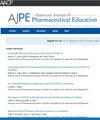在高级药学实践经验中使用基于委托专业活动的评估的实习医师观点。
IF 3.8
4区 教育学
Q1 EDUCATION, SCIENTIFIC DISCIPLINES
引用次数: 0
摘要
目的探讨高级药学实践经验(APPE)戒酒师的观点,包括在药学体验教育中使用可委托专业活动(EPA)评估的实施建议、障碍和促进因素:方法:进行了两次 90 分钟的虚拟焦点小组会议,通过半结构化讨论,阐明戒酒师对将 EPA 纳入 APPE 的看法。去年至少有四名 APPE 学员接受过委托-监督(ES)量表和 EPA 评估的戒酒师符合条件。主要成果是对使用 EPA 框架评估学习者的实施指导的描述。次要成果包括描述在 APPE 学员评估中使用 EPA 框架的障碍和促进因素。所有会议都进行了记录、转录,并使用归纳式主题分析法进行了分析:代表 9 所院校的 11 名 APPE 戒酒员参加了会议。共同确定的实施建议包括:使用案例实践点燃片对戒酒师进行定期、重复的教育,对学生进行评估期望的引导,明确划分最低能力水平,经常与戒酒师进行讨论,以及利用机构资源。已确定的障碍包括:可委托性的抽象性、ES量表和戒酒师评估的主观性、评分标准不明确、评估的长度和复杂性以及EPA对特定实践环境的适用性。常见的促进因素包括明确定义的量表和期望值、戒酒师教育、学生教育、及格/不及格评分标准以及更短、更频繁的评估:结论:基于 EPA 的评估可以在 APPE 中被戒护员用于基于工作场所的评估。教员/实习生的发展和学生的引导需要基准和明确的期望来支持实施。本文章由计算机程序翻译,如有差异,请以英文原文为准。
Preceptor Perspectives Using Entrustable Professional Activity-Based Assessments During Advanced Pharmacy Practice Experiences
Objective
To explore advanced pharmacy practice experience (APPE) preceptor perspectives including implementation recommendations, barriers, and facilitators to using entrustable professional activity (EPA) assessment in pharmacy experiential education.
Methods
Two 90-min virtual focus group sessions were conducted to elucidate preceptor perspectives on EPA integration into APPEs through semistructured discussion. Preceptors with experience utilizing entrustment-supervision scales with EPAs for assessments for at least 4 APPE learners in the last year were eligible. The primary outcome was a description of implementation guidance for assessing learners using an EPA framework. Secondary outcomes include descriptions of barriers and facilitators to using an EPA framework in APPE learner assessment. All sessions were recorded, transcribed, and analyzed using inductive thematic analysis.
Results
Eleven APPE preceptors representing 9 institutions participated. Commonly identified implementation recommendations were regular, repetitive preceptor education using case practice vignettes, student orientation to assessment expectations, clear delineation of minimum competency level, frequent discussions with preceptors, and use of institutional resources. Identified barriers were the abstractness of entrustability, subjectivity of the entrustment-supervision scale and preceptor assessments, unclear grading schemes, length and complexity of the assessments, and EPA applicability to the specific practice setting. Commonly identified facilitators were clearly defined scales and expectations, preceptor education, student education, pass/fail grading schemes, and shorter, more frequent assessments.
Conclusion
EPA-based assessments can be used by preceptors for workplace-based assessments during APPEs. Faculty/preceptor development and student orientation with benchmarking and clear expectations are needed to support implementation.
求助全文
通过发布文献求助,成功后即可免费获取论文全文。
去求助
来源期刊
CiteScore
4.30
自引率
15.20%
发文量
114
期刊介绍:
The Journal accepts unsolicited manuscripts that have not been published and are not under consideration for publication elsewhere. The Journal only considers material related to pharmaceutical education for publication. Authors must prepare manuscripts to conform to the Journal style (Author Instructions). All manuscripts are subject to peer review and approval by the editor prior to acceptance for publication. Reviewers are assigned by the editor with the advice of the editorial board as needed. Manuscripts are submitted and processed online (Submit a Manuscript) using Editorial Manager, an online manuscript tracking system that facilitates communication between the editorial office, editor, associate editors, reviewers, and authors.
After a manuscript is accepted, it is scheduled for publication in an upcoming issue of the Journal. All manuscripts are formatted and copyedited, and returned to the author for review and approval of the changes. Approximately 2 weeks prior to publication, the author receives an electronic proof of the article for final review and approval. Authors are not assessed page charges for publication.

 求助内容:
求助内容: 应助结果提醒方式:
应助结果提醒方式:


